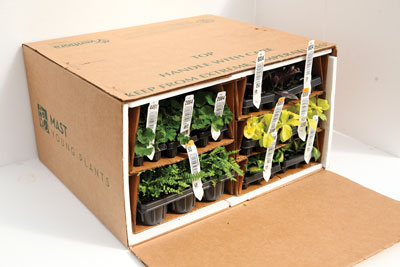3/1/2022
Successful Young Plant Receiving
Michael DeBerti

It seems everything nowadays comes with some sort of warranty. Most products certainly come with that special pledge from the manufacturer that guarantees the product purchased will be viable with no problems for a certain amount of time. If problems do arise, the supplier will make some sort of restitution if it’s in the specified time frame.
Most young plant invoices have a footnote on what could be categorized as a warranty. They tend to be legal sounding, so I’m not sure every customer takes the time to read them. “Seller warrants that the products it supplies will be in accordance with descriptions supplied by Seller.” It usually continues with an odd number of words in a mini box of text that ends with some form of manufacturer pledge.
As the Head Grower here at our facility, I wear the hat of technical support for the young plant product. We have a large customer base with companies of various sizes and during liner production season I find myself talking to a large amount of these growing customers. Often the customer wants us to take responsibility for what’s currently happening to their product, whether it’s only a few weeks old or at an older stage of growth.
As a company, we stand behind the product we produce, and if there’s an issue caused by us, we’ll resolve it to the customer’s satisfaction. As a grower, I’m aware of the many aspects it takes to produce a finished plant. After all, I finish a good many plants for various seasons and some of these starts aren’t all from my own production. If things don’t work out as expected, I must check off a few boxes before sending up an alarm for a claim on the product that I received.
We’ve all dealt with shipping issues, be it mechanical damage, heat, cold or lost parcels that are in a black hole somewhere. These are issues that fall under the statement of the seller failing to meet expectations. Though not entirely caused by the supplier, it’s a claim they should honor.
Beyond the initial receiving, a few boxes should be checked by the receiver before entering a claim:
1. Give your product the attention it demands upon receiving. Often, we bring in material from an outside source. Regardless of the processes in place at your facility, you must be sure the product is getting the attention it needs at receiving. It’s possible for product to be lost in the shuffle of daily shipping and receiving, and therefore not unboxed and examined in a timely manner. There have been times that I’ve lost product because it was left in a box, pushed to the side unattended, or the plants were put on a rack, but not watered before being placed in the greenhouse. Generally, I find that if it’s racked soon after receiving and subsequently watered, the potential for loss is significantly reduced. The temperature of the holding area for the product also plays a critical part. Cold damage can occur not only during shipping, but inside a facility as well. Plant placement during its receiving is imperative. We need to be on the lookout for those winter drafts.
2. Always dislodge liners properly. One of my least favorite terms that our Young Plant Manager throws my way when he’s addressing a credit is “lightly rooted.” I occasionally can agree with the claim, but I often wonder if the liners are being dislodged appropriately. Moist soil allows for better dislodging and will prevent the plant from being separated from its soil ball. Dislodging the plugs prior to planting can prevent many shortages and plant damage. The key is to watch the crew on how they’re gripping the plants to pull them from the tray. I’ve witnessed the planter separating the root system from the stem by their grip-and-pull method. Proper training and diligent supervision can prevent this issue.
3. Manage the growing environment appropriately. A few other points to consider after the young plant has survived shipping and planting is solely up to the owner of the plant. The growing environment for the first few weeks is a good culprit of causing issues for a grower who then doesn’t see the expected performance. Colder temperatures can slow growth exponentially and open the gate for disease issues. Fungicides are many times negated to the point that if conditions aren’t just right, they can also invite complications. An application of a fungicide for the genera’s biggest disease concern can make a major difference in the plants’ ability to become established. Be aware of where the plant is going to be growing. Many times, we don’t see the potential issues lurking in nearby existing crops or weeds. We need to understand that pests can be present in the area and not necessarily a hitchhiker on the new material. Failure to scout regularly and spray preventatively can be another reason for the lack of plant performance.
As a supplier, and many times a receiver, I speculate that by checking these three boxes, we can assure a successful product to where we don’t need to read the fine print on the invoice and wonder if the supplier’s warranty will cover our mistakes. GT
Michael DeBerti is Senior Grower for Mast Young Plants in Grand Rapids, Michigan.